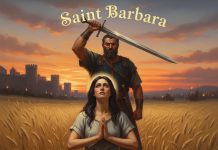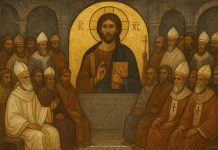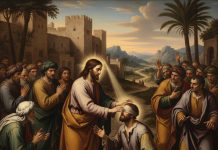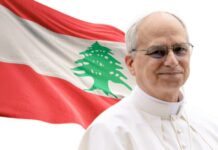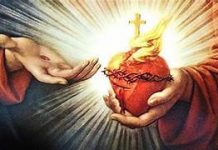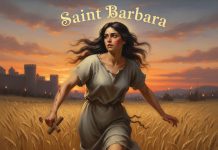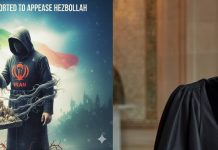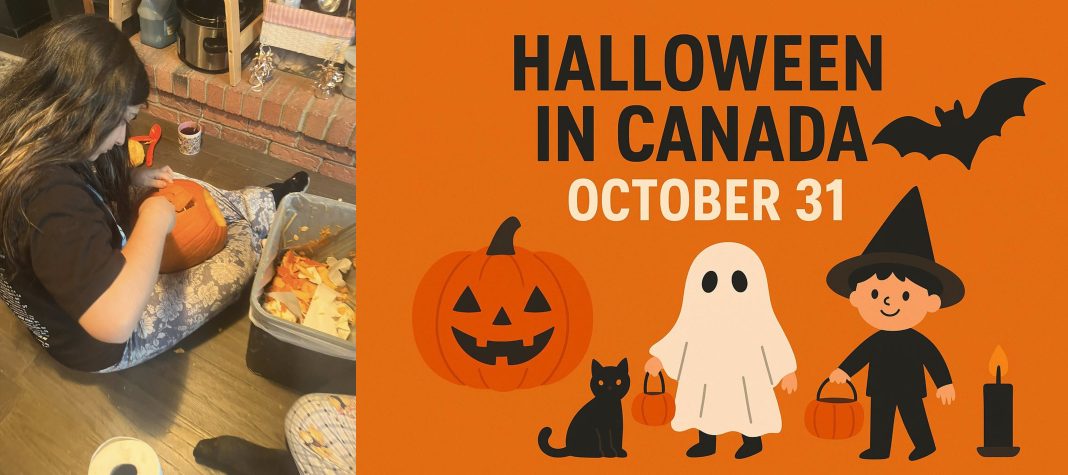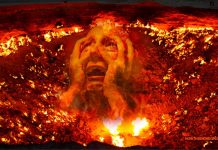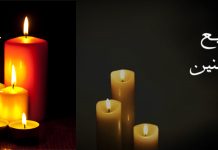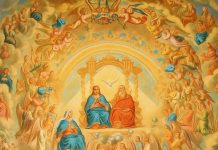Halloween in Canada: Concepts, Religious Background, and the Role of Native Canadian Traditions
Elias Bejjani/October 31/2025
الهالوين في كندا: المفهوم، الخلفية الدينية، ودور السكان الأصليين
الياس بجاني/31 تشرين الأول/2025
التعريف والمفهوم العام
يُحتفل بعيد الهالوين في كندا كل عام في 31 تشرين الأول (أكتوبر)، وهو من أكثر المناسبات شعبية وبهجة في البلاد. يتميّز هذا اليوم بارتداء الأطفال والبالغين للأزياء التنكرية، وتزيين المنازل باليقطين (القرع) المنحوت، وتنظيم الحفلات، إضافة إلى جوال الأطفال بين المنازل مردّدين عبارة “حيلة أم حلوى” (Trick or Treat) لجمع الحلوى والهدايا. وعلى الرغم من أنّ الهالوين اليوم أصبح احتفالًا ترفيهيًا، إلا أن جذوره تمتد إلى عصور قديمة، وتجمع بين عناصر دينية وثقافية وشعبية.
الخلفية التاريخية والدينية
تعود أصول الهالوين إلى مهرجان “سامهين” (Samhain) الذي كان يحتفل به القدماء الكلت في أيرلندا واسكتلندا وفرنسا القديمة. كانوا يعتقدون أن ليلة 31 تشرين الأول- أكتوبر هي الوقت الذي يقترب فيه عالم الأحياء من عالم الأموات، فكانوا يشعلون النيران ويرتدون أقنعة لإبعاد الأرواح الشريرة. ومع انتشار المسيحية في أوروبا، حاولت الكنيسة تحويل هذه الاحتفالات إلى طابع مسيحي. فقام البابا غريغوريوس الثالث في القرن الثامن بتحديد الأول من تشرين الثاني (نوفمبر) يومًا لتكريم القديسين، وأطلق عليه اسم عيد جميع القديسين، وأصبحت الليلة السابقة له، أي 31 تشرين الأول-أكتوبر، تُعرف باسم “عشية جميع القديسين” أو Halloween. وبذلك، أصبح الهالوين مزيجًا من المعتقدات الوثنية القديمة والرموز المسيحية المرتبطة بذكرى الموتى.
دور الهنود الكنديين الأصليين
قبل وصول المستوطنين الأوروبيين، كان للسكان الأصليين في كندا احتفالاتهم الخاصة بنهاية موسم الحصاد وتكريم أرواح الأجداد. وعندما جاء المهاجرون الأيرلنديون والاسكتلنديون إلى كندا في القرن التاسع عشر، حملوا معهم تقاليد الهالوين، فاختلطت مع عادات السكان الأصليين التي كانت تُعنى بالتواصل مع الطبيعة واحترام دورة الحياة والموت. ومع مرور الوقت، تحوّل الهالوين في كندا إلى مناسبة ثقافية وطنية تجمع بين الفلكلور الأوروبي والروح الروحية للسكان الأصليين.
فكرة القرع (اليقطين) ونحته
يُعتبر اليقطين المنحوت من أبرز رموز الهالوين اليوم. تعود هذه العادة إلى أسطورة أيرلندية قديمة عن رجل يُدعى “جاك البخيل” (Stingy Jack)، الذي خدع الشيطان وحُكم عليه بأن يتجوّل في الأرض حاملاً فانوسًا داخل ثمرة لفت مجوّفة. وعندما وصل المهاجرون الأيرلنديون إلى أمريكا الشمالية، وجدوا أن اليقطين أسهل للنحت وأكبر حجمًا من اللفت، فاستبدلوه به.وأصبح وضع شمعة داخل القرع المنحوت يرمز إلى إبعاد الأرواح الشريرة وإضاءة الطريق للأرواح التائهة.
الهالوين والمسيحية
يرتبط الهالوين جزئيًا بالاحتفالات المسيحية مثل عيد جميع القديسين (01 تشرين الثاني- نوفمبر) وعيد جميع الأرواح (02 تشرين الثاني-نوفمبر)، لكنه اليوم يُعتبر احتفالًا اجتماعيًا وعلمانيًا أكثر منه دينيًا. أما الكنيسة الكاثوليكية فلا تُحرِّم الاحتفال بالهالوين، لكنها تدعو المؤمنين إلى تجنّب الممارسات التي تمجّد الشر أو السحر أو الشيطان، وتشجع على التذكّر الإيجابي لأرواح الموتى والقديسين. في المقابل، تعارض بعض الطوائف البروتستانتية والإنجيلية الهالوين، معتبرة أنه يُروّج لأفكار مظلمة تتنافى مع الإيمان المسيحي، ولذلك ينظمون احتفالات بديلة مثل مهرجان الحصاد أو ليلة القداسة.
هل الهالوين عيد للشيطان؟
يعتقد البعض أن الهالوين هو احتفال شيطاني، لكن هذا غير صحيح. فالهالوين لم يُنشأ لعبادة الشيطان، بل كان في الأصل احتفالًا بمواجهة الخوف والموت بالجرأة والإيمان.الرموز مثل الهياكل العظمية والأشباح ليست تمجيدًا للشر، بل تعبير عن فهم الإنسان للطبيعة الغامضة للموت والحياة. أما في أيامنا، فأصبح الهالوين مناسبة للتسلية والإبداع والمشاركة الاجتماعية، لا علاقة لها بأي طقوس دينية أو شيطانية.
الاحتفالات الحديثة في كندا
في كندا، يُعتبر الهالوين من أبرز المناسبات الوطنية. تُزيَّن البيوت باليقطين المضيء، والأشباح، والعناكب البلاستيكية، بينما يرتدي الأطفال أزياء تنكرية لشخصيات خيالية ويجولون على المنازل لجمع الحلوى. تُنظَّم في المدن الكبرى مثل تورونتو ومونتريال وفانكوفر وهاليفاكس مهرجانات ومسيرات وفعاليات ترفيهية، وتُطلق حملات توعية لضمان سلامة الأطفال أثناء جولاتهم الليلية. وبينما يُعتبر الهالوين للأطفال مناسبةً للفرح والمرح، يراه الكبار فرصةً للتفكير في دورة الحياة والموت وأسرار العالم الروحي.
الخلاصة
يمثل الهالوين في كندا اليوم مزيجًا فريدًا من التراث الكلتي القديم، والرموز المسيحية، والروح الكندية الحديثة. قد يراه البعض احتفالًا بريئًا، فيما يراه آخرون فرصة لتذكّر الموتى والتأمل في معنى الحياة. لكن الحقيقة هي أن معنى الهالوين يعتمد على الطريقة التي نحتفل بها — فإذا كان بروح إيجابية، فهو مناسبة جميلة تجمع الناس وتنتصر فيها الأنوار على الظلمات.
Halloween in Canada: Concepts, Religious Background, and the Role of Native Canadian Traditions
Elias Bejjani/October 31/2025
Definition and General Concept
Halloween, celebrated every year on October 31, is one of the most popular and colorful events in Canada. Known for costumes, pumpkin decorations, haunted houses, and children roaming neighborhoods shouting “Trick or Treat!”, it is a blend of ancient pagan rituals, Christian traditions, and modern secular customs. Although today Halloween is mainly associated with fun, candy, and costumes, its origins are deeply rooted in ancient religious beliefs and cultural practices that date back thousands of years.
Historical and Religious Background
The origins of Halloween go back to the ancient Celtic festival of Samhain (pronounced Sow-in), celebrated in what is now Ireland, Scotland, and parts of France. The Celts believed that on the night of October 31, the boundary between the world of the living and the dead became blurred. They lit bonfires and wore costumes to ward off wandering spirits. When Christianity spread through Europe, the Church sought to replace or Christianize these pagan celebrations. In the 8th century, Pope Gregory III designated November 1 as All Saints’ Day (All Hallows’ Day) — a day to honor saints and martyrs. The evening before it, October 31, became known as All Hallows’ Eve, which later evolved linguistically into “Halloween.”Thus, Halloween as we know it today is a mix of pagan and Christian influences — a fusion of the Celtic belief in spirits and the Christian remembrance of the dead.
The Role of Native Canadian Indians
Before European settlers arrived, Indigenous peoples across North America had their own autumn festivals to mark the end of harvest and to honor the spirits of ancestors. While these Indigenous traditions were not directly related to the Celtic Samhain, they shared a spiritual connection with nature, life, and death. When European immigrants — especially from Ireland and Scotland — brought Halloween to Canada in the 1800s, the celebration gradually mixed with Native Canadian storytelling, seasonal harvest ceremonies, and community gatherings. Over time, Halloween in Canada became a cultural event reflecting both European folklore and Indigenous respect for the spirit world and nature’s cycles.
The Origin and Meaning of the Pumpkin Tradition
The pumpkin has become the most recognizable symbol of Halloween. The tradition of carving faces into pumpkins, known as “jack-o’-lanterns,” began with an old Irish legend about a man named Stingy Jack, who tricked the devil and was condemned to wander the earth carrying a lantern made from a carved-out turnip. When Irish immigrants came to North America, they discovered that pumpkins were larger and easier to carve than turnips, and thus they replaced the original vegetable. Lighting a candle inside the carved pumpkin came to symbolize guidance for lost spirits and protection from evil ones, turning the pumpkin into both a symbol of creativity and a charm against darkness.
Halloween and Christianity: Connections and Controversies
While Halloween’s roots touch Christian traditions such as All Saints’ Day (November 1) and All Souls’ Day (November 2), its modern expression has become largely secular and commercial. Many Christians — especially Catholics and Anglicans — observe All Saints’ Day as a holy day of obligation, remembering the faithful who have passed away. For them, the evening before (Halloween) can be seen as a time of reflection rather than superstition.
However, certain Christian denominations, particularly Evangelical and conservative Protestant groups, view Halloween negatively. They argue that its focus on ghosts, witches, and demons glorifies evil or the devil, rather than goodness and holiness.This belief has led some families and churches to avoid Halloween celebrations or to organize “Harvest Festivals” or “Holy Nights” as wholesome alternatives. The Catholic Church, on the other hand, does not officially condemn Halloween, but it encourages believers to avoid practices that promote superstition, occultism, or satanic imagery. Many Catholic educators emphasize that Halloween’s original intent was to honor the saints and pray for the dead, not to celebrate evil.
Is Halloween a Celebration of the Devil?
Despite widespread claims, Halloween is not a “devil’s day.”
Historically, it was a time to confront fear and darkness with courage and faith, not to worship evil. The imagery of ghosts, skeletons, and demons represented the human confrontation with death and the unknown — central themes in both pagan and Christian worldviews. In modern culture, Halloween’s connection to the supernatural is largely symbolic and playful. Most people who celebrate it today do so for entertainment, creativity, and community fun, rather than for any religious or anti-religious reason.
Modern Celebrations in Canada
In Canada, Halloween has become a nationally recognized cultural celebration.
Communities, schools, and families decorate homes with pumpkins, lights, and spooky figures. Children dress up as superheroes, ghosts, or fairy-tale characters and go from door to door saying “Trick or Treat!” — a phrase dating back to medieval times when poor people begged for “soul cakes” in return for prayers for the dead. Canadian cities like Toronto, Montreal, Vancouver, and Halifax host Halloween parades, haunted house events, and pumpkin festivals. Safety campaigns are also widespread, emphasizing reflective clothing, adult supervision, and careful candy checks. For children, Halloween is primarily about joy, imagination, and sharing. For adults, it can also be a chance to reflect on the mystery of life, death, and the spiritual world — echoing its ancient roots.
Conclusion
Halloween in Canada today stands as a fusion of ancient Celtic rituals, Christian remembrance, and modern social fun. While some view it as a harmless cultural festival, others see it as a reminder to avoid glorifying darkness. The truth lies somewhere in between: Halloween’s true meaning depends on how it is celebrated. If approached with understanding, creativity, and moral awareness, Halloween can be a positive occasion — a night that connects the living with their past, strengthens community bonds, and celebrates the victory of light over darkness.



